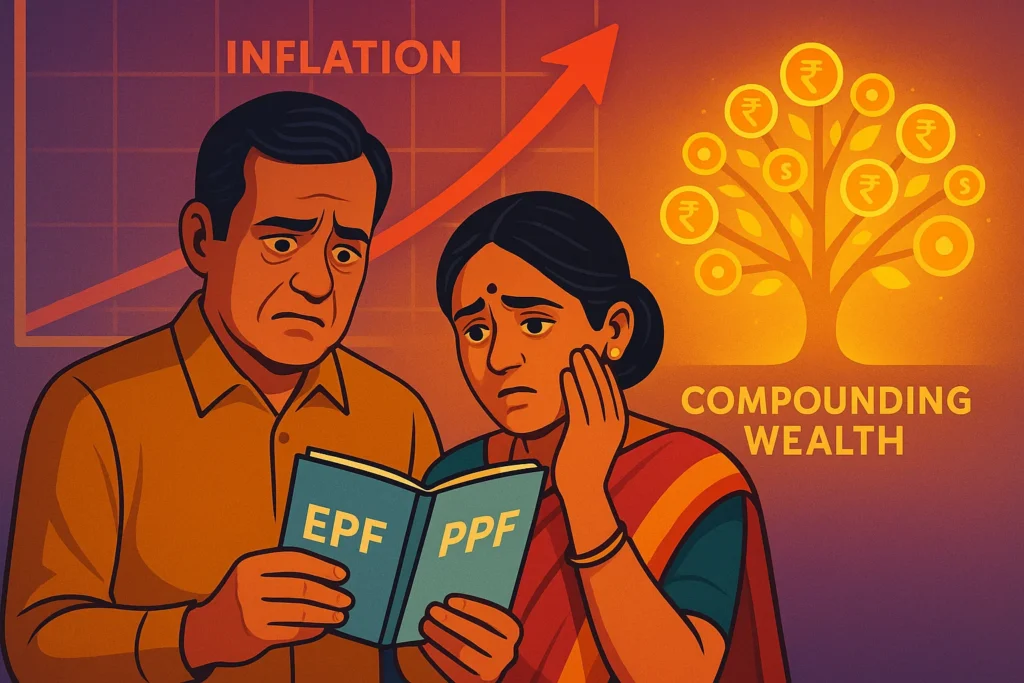Introduction
Retirement is no longer a distant dream for Indians—it is becoming a looming financial challenge. With rising life expectancy, inflation, and medical costs, India is quietly walking into a storm: the Indian retirement savings crisis.
For decades, most working professionals have assumed that EPF (Employees’ Provident Fund) and PPF (Public Provident Fund) would take care of retirement. But the truth is, EPF and PPF won’t be enough. If you rely only on these two, you risk running out of money in your later years.
In this blog, we will explore:
- Why India is facing a retirement crisis
- Why EPF and PPF fall short
- Hard numbers that show the gap
- Smarter alternatives to secure your retirement
Why India is Headed Towards a Retirement Savings Crisis
The Indian retirement savings crisis is real and growing. Let’s understand the reasons:
- Low Pension Coverage
- Over 90% of India’s workforce is in the unorganized sector, with no pension benefits.
- Even in the organized sector, only salaried employees under EPF enjoy systematic savings.
- Longer Lifespan, Shorter Corpus
- In the 1980s, life expectancy was 55–60 years.
- Today, average life expectancy is 70–75 years, and many live well into their 80s.
- This means retirees need funds for 20–25 years post-retirement, not just 10–15.
- Inflation Eats Savings
- General inflation averages 6%.
- Healthcare inflation is almost 12% per year.
- What looks like a big corpus today will shrink drastically in purchasing power.
- Changing Family Structure
- Earlier, joint families ensured financial support.
- Today, with nuclear families, retirees must be financially independent.
All of these factors point to one harsh reality: EPF and PPF won’t be enough to cover retirement needs.
Why EPF and PPF Fall Short
Let’s break down why these two popular savings instruments cannot single-handedly tackle the retirement challenge.
| Feature | EPF | PPF | Why It’s Not Enough |
|---|---|---|---|
| Contribution Limit | Linked to salary (12% + employer share) | Max ₹1.5 lakh/year | Limited scope, won’t build large corpus |
| Interest Rate (2025) | 8.25% | 7.1% | Declining vs inflation |
| Liquidity | Partially withdrawable | 15-year lock-in | Not flexible |
| Inflation Adjustment | Poor | Poor | Real returns just 1–2% |
| Corpus Built in 30 years | ₹70–80 lakh | ₹60–70 lakh | <₹1.5 crore, far below requirement |
👉 Together, EPF and PPF build a maximum of ₹1.5 crore in 30 years, but actual retirement needs exceed ₹4–5 crore.
The Numbers Behind the Retirement Gap
Let’s compare two scenarios for a salaried person.
Example: 30-year-old, ₹50,000 monthly salary, retirement at 60
| Saving Method | Contribution | Rate of Return | Corpus at 60 | Adequate? |
|---|---|---|---|---|
| EPF + PPF Only | ₹10,000 (EPF) + ₹1.5 lakh/year (PPF) | 7–8% | ~₹1.4 crore | ❌ No |
| Equity SIP | ₹10,000/month | 12% | ~₹3.5 crore | ✅ Yes |
| NPS (Equity+Debt) | ₹10,000/month | 9–10% | ~₹2 crore | Partial |
| EPF + PPF + Equity SIP | Balanced portfolio | Mixed | ~₹4–5 crore | ✅ Safe |
The table clearly shows: EPF and PPF won’t be enough. You need equity exposure and diversification.
Transitioning from Traditional to Modern Retirement Planning
If you only rely on EPF and PPF, you will fall into the Indian retirement savings crisis trap. Instead, consider these alternatives:
1. Equity Mutual Funds & Index Funds
- Long-term CAGR: 12–14%.
- A ₹10,000 SIP for 30 years = ₹3.5 crore.
- Best inflation-beating asset.
2. NPS (National Pension System)
- Mix of equity, corporate debt, and government bonds.
- Extra tax benefit of ₹50,000 (Sec 80CCD 1B).
- Provides annuity after retirement.
3. REITs and InvITs
- Exposure to real estate and infrastructure.
- Regular income through dividends.
4. Gold and Sovereign Gold Bonds (SGBs)
- Hedge against inflation.
- Historical CAGR ~8–9%.
5. Health Insurance + Term Insurance
- Protects corpus from medical shocks.
- Ensures family security.
The Power of Compounding: A Comparison
| Investor | Investment Type | Monthly Investment | Duration | Expected Return | Corpus at 60 |
|---|---|---|---|---|---|
| A | PPF Only | ₹12,500 | 30 years | 7.1% | ₹1.2 crore |
| B | Equity SIP Only | ₹12,500 | 30 years | 12% | ₹4.5 crore |
| C | EPF + PPF | Salary linked + ₹1.5 lakh/year | 30 years | 7.5% | ₹1.4 crore |
| D | EPF + PPF + Equity SIP | Same as above + ₹10k SIP | 30 years | Mixed | ₹5 crore+ |
The difference between Investor A and Investor D is financial freedom vs financial struggle.
Check now with SIP Calculator.
Actionable Steps to Avoid Retirement Crisis
- Start Early: The earlier you start, the smaller the amount needed monthly.
- Diversify Investments: Don’t just depend on EPF and PPF.
- Increase SIPs with Salary Growth: Every increment, raise your investment share.
- Rebalance Portfolio: Adjust equity and debt allocation every 2–3 years.
- Plan for Healthcare: Take health insurance and build an emergency corpus.
Conclusion
The Indian retirement savings crisis is not a distant threat—it’s already here. With declining returns, rising costs, and longer life expectancy, EPF and PPF won’t be enough to sustain your retirement years.
If you want a stress-free retirement, you must go beyond traditional instruments. Equity mutual funds, NPS, REITs, and a diversified approach can create the wealth you need.
Remember, retirement planning is not about safety today, but security tomorrow. The earlier you prepare, the stronger you’ll stand against India’s retirement crisis.
FAQs: Indian Retirement Savings Crisis
1. What is the Indian Retirement Savings Crisis?
The Indian Retirement Savings Crisis refers to the growing gap between what people save through EPF and PPF versus the actual money needed for retirement.
2. Why is the Indian Retirement Savings Crisis happening?
The Indian Retirement Savings Crisis is happening due to inflation, rising healthcare costs, and people living longer than before.
3. Is EPF enough to solve the Indian Retirement Savings Crisis?
No, EPF alone cannot solve the Indian Retirement Savings Crisis because its returns are not sufficient to beat inflation.
4. Can PPF prevent the Indian Retirement Savings Crisis?
PPF is a safe savings option, but it cannot prevent the Indian Retirement Savings Crisis since it grows too slowly compared to future expenses.
5. Who is most affected by the Indian Retirement Savings Crisis?
Salaried employees relying only on EPF and PPF are most affected by the Indian Retirement Savings Crisis.
6. How can mutual funds help in the Indian Retirement Savings Crisis?
Equity mutual funds can provide higher long-term returns, making them an effective solution to tackle the Indian Retirement Savings Crisis.
7. What role does inflation play in the Indian Retirement Savings Crisis?
Inflation reduces the value of money, making it a key driver of the Indian Retirement Savings Crisis.
8. How much corpus is needed to avoid the Indian Retirement Savings Crisis?
On average, Indians need at least ₹2–3 crore for retirement to avoid the Indian Retirement Savings Crisis.
9. Can NPS solve the Indian Retirement Savings Crisis?
Yes, the NPS can help reduce the Indian Retirement Savings Crisis by combining equity growth with tax benefits.
10. What is the best way to overcome the Indian Retirement Savings Crisis?
The best way to overcome the Indian Retirement Savings Crisis is by diversifying into EPF, PPF, mutual funds, NPS, and other assets early.
More Articles
Real Money Gaming Ban India: UPI, Payments & Industry Impact
Amanta Healthcare IPO: 5 Powerful Positives & Risks Investors Must Know
Best IPOs in 2025: Top 10 Stocks That Doubled Investors’ Money




